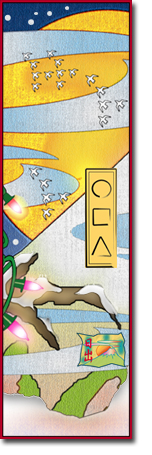On The Way: The Daily Zen Journal
Investigating Chan and Contemplating Mind
Xuyun (1839-1959)

Our sect focuses on investigating Chan and the purpose of investigating Chan is to “illuminate the Mind and see one’s own self-nature,” which means to thoroughly investigate and comprehend our original face. This investigation is also called “clearly realizing one’s Mind and thoroughly perceiving one’s intrinsic nature.”
Ever since the time when the Buddha held up a flower and Bodhidharma came to the East, the methods for entry into this Dharma door have continually evolved. Most Chan adepts before the Tang and Song dynasties became enlightened after hearing a word or phrase of the Dharma, and Dharma transmission from master to disciple was merely a convergence of Mind to Mind; there was no actual Dharma. Further, questions and answers in daily life were only extemporaneous occasions to untie entanglements, much like prescribing the right medicine for the right illness.
When you begin observing a huatou, even if you must begin with a lifeless phrase, you must grasp it tightly, without letting go of it even for an instant, like a mouse trying to gnaw its way out of a coffin. The mouse must focus on one area, and it must not stop until it gnaws through the coffin. In terms of huatou, the objective is to use a single thought to eradicate ten thousand thoughts. This method is really a last resort. Just as if someone had been severely poisoned and there was no other way to get the poison out and cure the patient except to open up the body.
After the Song dynasty, however, people did not have such good karmic capacities as their predecessors. They could not carry out what had been said. For example, practitioners were taught to “put down everything” and “not think about good and evil,” but they could not put down everything; if they weren’t thinking about good, they were thinking about evil. Under these circumstances, the patriarchs had no choice but to use poison against poison, and taught practitioners to investigate gong’an (and huatou).
In fact, all huatous follow the same format. There is nothing uncommon, strange, or special about them. If you wanted to, you could observe: “Who is reciting the sutras?” “Who is reciting the mantras?” “Who is prostrating to Buddha?” “Who is eating?” “Who is wearing these clothes?” “Who is walking?” “Who is sleeping?”
They’re all the same. The answer to the word who derives from one’s Mind; Mind is the source of all words. Thoughts arise from the Mind; the Mind is the source of all thoughts. Innumerable dharmas are born out of the Mind; Mind is the source of all dharmas. In fact, hautou (literally meaning “the source of words”) is the source of thought. And the source of thoughts is the Mind. To put it directly, the state of mind before any thought arises is huatou.
Hence, we should know that observing huatou is contemplating Mind. Your “original face” before your parents gave birth to you is the Mind, and observing the huatou “What is my original face before my parents gave birth to me?” is contemplating Mind.
Self-nature is Mind. When one “turns inward to hear one’s self-nature,” one is turning inward to contemplate Mind. In the phrase, “perfectly illuminating pure awareness,” the “pure awareness” is Mind, and “illumination” is contemplation. Mind is Buddha. When one recites Buddha’s name one contemplates Buddha. And contemplating Buddha is contemplating Mind.
Thus, observing the huatou, such as observing “Who is reciting Buddha’s name?” is contemplating Mind. That is, “illuminating the pure awareness” of your Mind, or illuminating the Buddha of your self-nature. Mind is nature, is pure awareness, and is Buddha. It has no form, no characteristics, no fixed location; it cannot be grasped and as such is intrinsically pure. It pervades all Dharma realms; it does not exist or enter; it does not come or go. The Mind is the intrinsically self-manifested, pure dharmakaya Buddha.
You practitioners should first shut down all six sense faculties and observe the place where thoughts arise and take care of this “source of words,” or huatou; observe it until you perceive your pure Mind separated from all thoughts. Advancing further, your practice must be seamless, without any interruption, and your mind must be refined, quiescent, and luminous. Continue until the five skandhas are empty and your body and mind become quiescent.
There is nothing for you to do. From that point onward, activities of walking, standing, sitting, and lying are all performed in stillness. In time, your practice will deepen and you will see your self-nature and become a Buddha. Master Gaofeng (1238-1295) once said: “You must observe the huatou like a sinking roof tile plummeting down into a pond ten thousand feet deep. If in seven days you are not enlightened, you have permission to chop off my head!” Fellow practitioners, these are the words of one who has already reached the other shore. His words are true; they are not boastful words that deceive us!
Still, why is it that in our modern times, although there are many practicing huatou, few actually reach enlightenment? This is because practitioners today have karmic capabilities inferior to those of practitioners of the past. Also, practitioners today are unclear about the principle and path of huatou practice.
Some practitioners sojourn from east to west and north to south to practice (under different masters) until they die but still haven’t penetrated even one huatou. They don’t know the meaning of huatou and are unsure what would be considered “observing the huatou.” All of their lives they only attach to the words and labels, exerting their effort (not on the “source” of words but) at the tail end of words.
Huatou is precisely the One Mind. This One Mind that is within you and me is not inside, outside, or in the middle. Like the stillness of empty space, it pervades everywhere.
When using the huatou, you should not raise it upward (that is, focus on it in your head region) or suppress it downward (that is, psychologically force the huatou to sink to the lower body). If you raise it upward, you will arouse scattered mind. If you suppress it, you will drift into drowsiness. These approaches are contrary to your mind’s original nature and are not in accordance with the Middle Way.
Practitioners are distressed by wandering thoughts. They believe it is difficult to subdue wandering thoughts. Let me state it clearly: don’t be afraid of wandering thoughts, and do not waste your energy subduing them. All you have to do is recognize them. Don’t attach to them, don’t follow them, and don’t try to get rid of them. As long as you do not continue wallowing in them, wandering thoughts will naturally depart by themselves.
Master Xuyun (1839-1959)
excerpted from Attaining the Way – a Guide to the Practice of Chan Buddhism- Sheng Yen 2006





For those of us who entered the doorway of Zen through “just sitting,” koan practice has always seemed a bit mysterious. Not that there isn’t a technique involved in sitting meditation but concentrating on a certain phrase or word is not part of that approach. Master Xuyun provided an excellent overview that helped me understand this. For some of us, the term huatou is new and deserves more explanation to help see the distinction.
His instructions on how to practice this method are clear, and most of us are not wandering East, West, South, or North seeking a teacher. Many of us are practicing on our own and have to adapt to what we have to work with right where we are. With many writings of the past, much emphasis is given to finding the right teacher and the necessity of doing so to verify one’s understanding. However, working with a teacher also has its challenges.
The vital point is to find a method and stick with it. The tasting of different approaches is fine for the dilettante or gourmet style of life, but serious practice takes commitment, time, and not giving up.
To study the Way is to study the self. To study the self is to forget the self. To forget the self is to be enlightened by all things. To be enlightened by all things is to remove the barriers between one’s self and others.
Dogen Zengi (1200-1253)
We are in reality no different from practitioners hundreds of years ago; many stories have become like mythology in Zen. The important thing is to avoid comparing our practice to others and “just do it.”
Steadfastly yours,
Elana, Scribe for Daily Zen